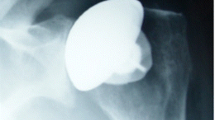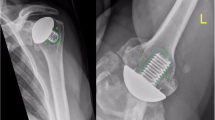Abstract
This prospective study aimed to analyse the effect of a newly developed double-eccentric adjustable stemmed prosthesis on reconstruction of the osseous anatomy, range of motion, strength and pain relief. A total of 91 consecutive hemiprostheses were evaluated preoperatively and three, six, 12, 24 and 48 months postoperatively (mean±SD 46.2 ± 10.9 months) by the American Shoulder and Elbow Surgeons (ASES) and Constant scores as well as radiological assessment. Clinical evaluations showed an increase in Constant score from 21.9 to 64.8 points and in ASES score from 24.9 to 77.9 points after two years. The results depend mainly on the underlying pathology. The best results were observed for primary osteoarthritis and avascular necrosis of the humeral head. All heads were eccentrically positioned. Specific stem-related complications were not observed. Because of the eccentric positioning of all heads it is reasonable to use adjustable shaft prostheses. The clinical results are comparable to data in the literature. Additional study provided a better or comparable clinical outcome and a low revision rate, when compared with other modern adjustable implants in the literature.





Similar content being viewed by others
References
Aldinger PR, Raiss P, Rickert M, Loew M (2010) Complications in shoulder arthroplasty: an analysis of 485 cases. Int Orthop 34:517–524
Boileau P, Chuinard C, Le Huec JC, Walch G, Trojani C (2006) Proximal humerus fracture sequelae: impact of a new radiographic classification on arthroplasty. Clin Orthop Relat Res 442:121–130
Büchler P, Farron A (2004) Benefits of an anatomical reconstruction of the humeral head during shoulder arthroplasty: a finite element analysis. Clin Biomech (Bristol, Avon) 19(1):16–23
Edwards TB, Kadakia NR, Boulahia A, Kempf JF, Boileau P, Némoz C, Walch G (2003) A comparison of hemiarthroplasty and total shoulder arthroplasty in the treatment of primary glenohumeral osteoarthritis: results of a multicenter study. J Shoulder Elbow Surg 12(3):207–213
Favre P, Moor B, Snedeker JG, Gerber C (2008) Influence of component positioning on impingement in conventional total shoulder arthroplasty. Clin Biomech (Bristol, Avon) 23(2):175–183
Godenèche A, Boileau P, Favard L, Le Huec JC, Lévigne C, Nové-Josserand L, Walch G, Edwards TB (2002) Prosthetic replacement in the treatment of osteoarthritis of the shoulder: early results of 268 cases. J Shoulder Elbow Surg 11(1):11–18
Habermeyer P, Engel G (2004) Shoulder endoprosthetics in osteoarthritis (in German). Oper Orthop Traumatol 16:339–364
Haines JF, Trail IA, Nuttall D, Birch A, Barrow A (2006) The results of arthroplasty in osteoarthritis of the shoulder. J Bone Joint Surg Br 88(4):496–501
Hertel R, Knothe U, Ballmer FT (2002) Geometry of the proximal humerus and implications for prosthetic design. J Shoulder Elbow Surg 11(4):331–338
Iannotti JP, Norris TR (2003) Influence of preoperative factors on outcome of shoulder arthroplasty for glenohumeral osteoarthritis. J Bone Joint Surg Am 85(2):251–258
Irlenbusch U, End S, Kilic M (2010) Differences in reconstruction of the anatomy with modern adjustable compared with second-generation shoulder prosthesis. Int Orthop (Epub ahead of print)
Irlenbusch U, Forke L, Fuhrmann U, Gebhardt K, Rott O (2010) Establishing the differential indication for anatomical and reversed shoulder endoprostheses in rheumatoid arthritis (in German). Z Rheumatol 69:240–249
Irlenbusch U, Fuhrmann U, Gebhardt K, Rott O (2008) Differential indication of anatomic and reversed shoulder prostheses in fracture sequelae (in German). Z Orthop Unfall 146:478–485
Mansat P, Huser L, Mansat M, Bellumore Y, Rongières M, Bonnevialle P (2005) Shoulder arthroplasty for atraumatic avascular necrosis of the humeral head: nineteen shoulders followed up for a mean of seven years. J Shoulder Elbow Surg 14(2):114–120
Mansat P, Mansat M, Bellumore Y, Rongières M, Bonnevialle P (2002) Mid-term results of shoulder arthroplasty for primary osteoarthritis (in French). Rev Chir Orthop Reparatrice Appar Mot 88(6):544–552
Matsen FA, Antoniou J, Rozencwaig R, Campbell B, Smith KL (2000) Correlates with comfort and function after total shoulder arthroplasty for degenerative joint disease. J Shoulder Elbow Surg 9(6):465–469
Matsoukis J, Tabib W, Guiffault P, Mandelbaum A, Walch G, Némoz C, Edwards TB (2003) Shoulder arthroplasty in patients with a prior anterior shoulder dislocation. Results of a multicenter study. J Bone Joint Surg Am 85(8):1417–1424
Neer CS, Watson KC, Stanton FJ (1982) Recent experience in total shoulder replacement. J Bone Joint Surg Am 64(3):319–337
Norris TR, Iannotti JP (2002) Functional outcome after shoulder arthroplasty for primary osteoarthritis: a multicenter study. J Shoulder Elbow Surg 11(2):130–135
Nyffeler WR, Sheikh R, Jacob HAC, Gerber C (2004) Influence of humeral prosthesis height on biomechanics of glenohumeral abduction. An in vitro study. J Bone Joint Surg Am 86(3):575–580
Orfaly RM, Rockwood CA, Esenyel CZ, Wirth MA (2003) A prospective functional outcome study of shoulder arthroplasty for osteoarthritis with an intact rotator cuff. J Shoulder Elbow Surg 12(3):214–221
Pearl ML, Kurutz S, Postachini R (2009) Geometric variables in anatomic replacement of the proximal humerus: how much prosthetic geometry is necessary? J Shoulder Elbow Surg 18:366–370
Sperling JW, Cofield RH, Rowland CM (2004) Minimum fifteen-year follow-up of Neer hemiarthroplasty and total shoulder arthroplasty in patients aged fifty years or younger. J Shoulder Elbow Surg 13(6):604–613
Topolski MS, Chin PY, Sperling JW, Cofield RH (2006) Revision shoulder arthroplasty with positive intraoperative cultures: the value of preoperative studies and intraoperative histology. J Shoulder Elbow Surg 15(4):402–406
Walch G, Boileau P (2004) Revision shoulder arthroplasty: lessons learned. In: Boileau P (ed) Shoulder arthroscopy and arthroplasty. Current Concepts. Nice Shoulder Course 2004. Sauramps Medical, Montpellier, pp 417–424
Walch G, Boileau P (1999) Prosthetic adaptability: a new concept for shoulder arthroplasty. J Shoulder Elbow Surg 8(5):443–451
Woodruff MJ, Cohen AP, Bradley JG (2003) Arthroplasty of the shoulder in rheumatoid arthritis with rotator cuff dysfunction. Int Orthop 27(1):7–10
Acknowledgements
We would like to thank D. Pfluger for statistical analysis and P. Münger for revising the English manuscript.
Conflict of interest
The independent statistical analysis was supported by Mathys Ltd., Bettlach, Switzerland. UI received consultant payments from Mathys.
Ethics standard
The study protocol was reviewed and approved by the Ethics Committee, St. Gallen, Switzerland, the Institutional Review Board of the Marienstift Arnstadt, Germany and the Ethics Committee of the Town of Vienna, Austria. All patients were informed preoperatively and provided their consent to participate in this study on a consent form.
Author information
Authors and Affiliations
Corresponding author
Rights and permissions
About this article
Cite this article
Irlenbusch, U., Blatter, G., Gebhardt, K. et al. Prospective study of double-eccentric hemi shoulder arthroplasty in different aetiologies: midterm results. International Orthopaedics (SICOT) 35, 1015–1023 (2011). https://doi.org/10.1007/s00264-010-1119-0
Received:
Revised:
Accepted:
Published:
Issue Date:
DOI: https://doi.org/10.1007/s00264-010-1119-0




